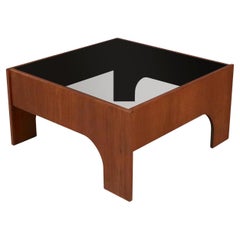Sormani
| Average Sold Price |
| $7,981 |
| Styles |
| Materials |
| Related Creators |
"Nike" Fiberglass Longue Chair by Richard Neagle for Sormani
By Richard Neagle, Sormani
Located in Milan, IT
"Nike" lounge chair by Richard Neagle for Sormani.
Large metal disc supports a reinforced fiberglass chair, padded with azure velvet upholstery.
Category
1960s Italian Vintage Sormani
Materials
Fiberglass, Velvet
Bookshelf by Sormani for Roche Bobois Green Lacquer and Stained Cherrywood, 1990
By Sormani, Roche Bobois
Located in Arosio, IT
This sculptural wave-shaped cabinet was designed by Emilio Rossi and produced by Sormani for the prestigious French brand Roche Bobois in Italy in the early 1990s. An exceptional exa...
Category
1990s Italian Mid-Century Modern Sormani
Materials
Wood
$1,893 Sale Price
20% Off
H 49.22 in W 39.38 in D 20.48 in
One-Off 1964 Rotating Bookshelf Centro, Claudio Salocchi for Sormani, Italy
By Sormani, Claudio Salocchi
Located in Arosio, IT
Rotating “Centro” bookshelf by Claudio Salocchi for Sormani, custom-made in the early 1970s for Luigi Sormani, the manufacturer of the well-known “Centro” bookshelf system. The “Cent...
Category
1960s Italian Mid-Century Modern Vintage Sormani
Materials
Metal
$43,126
H 84.65 in W 30.71 in D 30.71 in
Pair of 'Prismar' Table Lamp by Studio Arditi for Nucleo Sormani
By Sormani, Nucleo
Located in Los Angeles, CA
Pair of 'Prismar' Table Lamp by Studio Arditi for Nucleo Sormani. Designed and manufactured in Italy, in 1972. All-mirrored cubic table lamps with chrome details. The glass panels ar...
Category
1970s Italian Mid-Century Modern Vintage Sormani
Materials
Chrome
$14,500 / set
H 12 in W 12 in D 12 in
Gianni Songia Leather Daybed and Sofa for Sormani, Italy, 1963
By Sormani, Gianni Songia
Located in Moreno Valley, CA
Gianni Songia GS195 leather daybed and sofa for Sormani, Italy, 1963
This three-seat daybed was designed by Gianni Songia for Sormani, Italy, in 1963.
Model GS-195 with leather cus...
Category
Mid-20th Century Italian Mid-Century Modern Sormani
Materials
Leather
Carlo Di Carli pair of armchairs rosewood brass leather 1966
By Carlo di Carli, Sormani
Located in Paris, IDF
Beautiful pair of Italian armchairs designed by Carlo De Carli in 1966, and produced by Sormani in the 1960s and 1970s. This pair reflects Carlo De Carli’s vision of furniture as an ...
Category
1960s Italian Mid-Century Modern Vintage Sormani
Materials
Brass
$39,640 / set
H 32.68 in W 36.23 in D 39.38 in
Claudio Salocchi “Oriolo” Smoke Glass Coffee Table for Sormani
By Sormani, Claudio Salocchi
Located in Los Angeles, CA
Transforming a piece of Mid-Century Modern furniture is like bringing history back to life, and we take this journey with passion and precision. With over 17 years of artisanal exper...
Category
1960s Italian Mid-Century Modern Vintage Sormani
Materials
Glass, Walnut
1980s Italian Tie Display Cabinet by Sormani – Handmade, Green Glossy Lacquer
By Sormani
Located in Arosio, IT
This unique wall-mounted display cabinet is a one-of-a-kind piece, specially commissioned for the exclusive Ichthys Boutique in Monte Carlo, France. Designed to elegantly showcase up...
Category
1980s Italian Mid-Century Modern Vintage Sormani
Materials
Wood
$3,320 Sale Price
39% Off
H 28.75 in W 28.75 in D 5.71 in
Browse all Furniture from Sormani
Shop NowSormani Sale Prices
This data represents a recent sample of sales made on 1stDibs during the specified years. All sales are anonymized.
| Sold Date | Sold Price | Category | Material | Creation Year | ||||||||||||||||||||||||||||||||||||||||||||||||||||||||
|
| $7,981 |
Average sold price of items in the past 12 months |
| $2,050-$15,500 |
| Sold price range of items in the past 12 months |
Creators Similar to Sormani
Sormani furniture for sale on 1stDibs.
Sormani furniture are available for sale on 1stDibs. These distinctive items are frequently made of wood and are designed with extraordinary care. There are many options to choose from in our collection of Sormani furniture, although brown editions of this piece are particularly popular. Many of the original furniture by Sormani were created in the mid-century modern style in europe during the 20th century. If you’re looking for additional options, many customers also consider furniture by Gastone Rinaldi, Gavina, and Gionathan de Pas & Donato D’Urbino & Paolo Lomazzi. Prices for Sormani furniture can differ depending upon size, time period and other attributes — on 1stDibs, these items begin at $432 and can go as high as $130,000, while a piece like these, on average, fetch $4,716.






